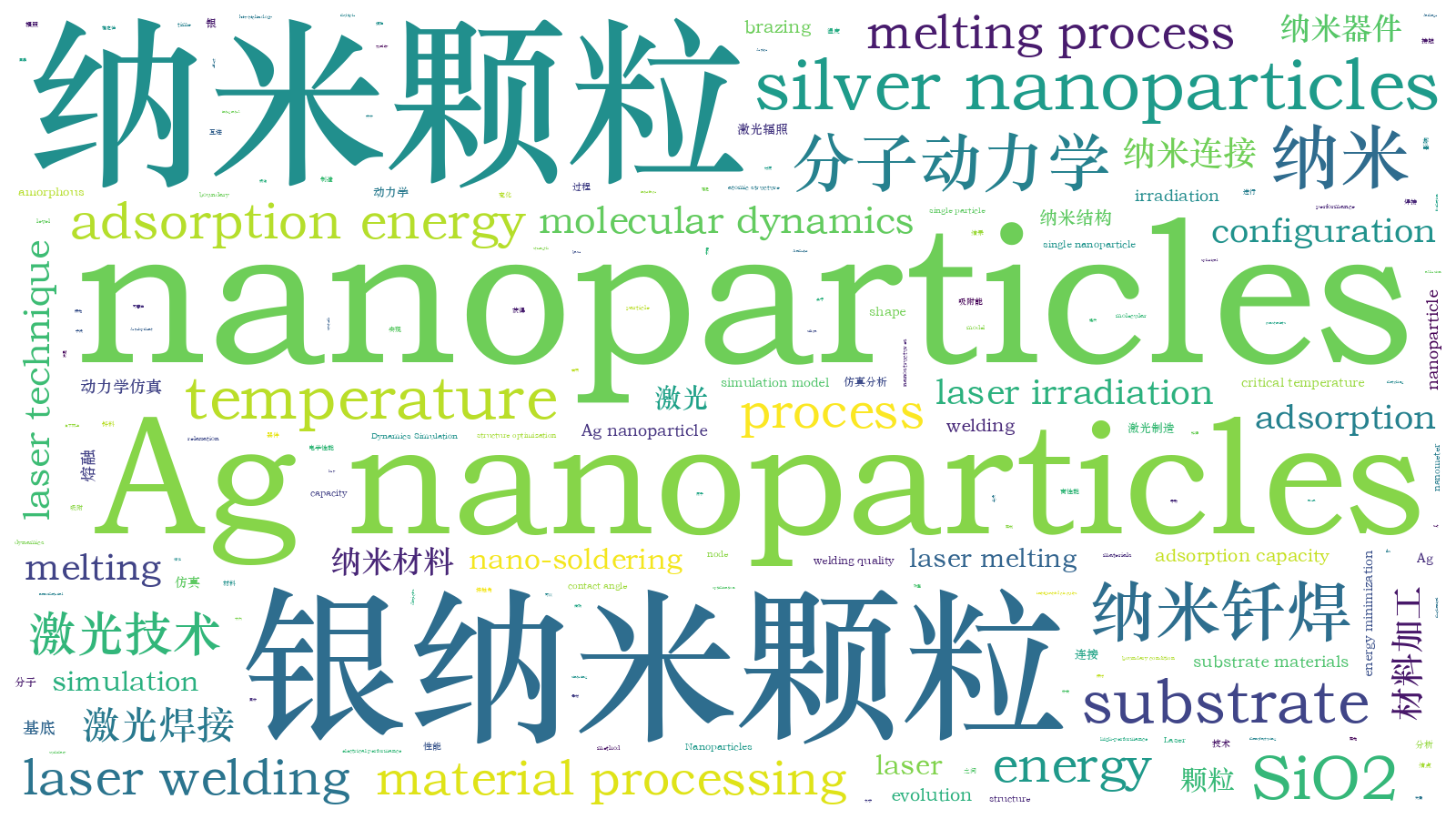激光熔融SiO2基底上银纳米颗粒分子动力学仿真  下载: 1283次
下载: 1283次
Objective As a technology of welding nanomaterials, nano-welding is not only an important “bottom-up” means for manufacturing nanostructures, but also a key technology for the development of high-performance integrated circuits with reliable interconnection points. Among all nano-welding methods, the nanometer brazing technology of melting nanomaterials under laser irradiation, as one of most reliable methods, is utilized to realize nano-device-level interconnection. This technology reduces the damage to the welding base materials, achieves the interconnection points with high mechanical strength, and even maintains the excellent electrical performance of the devices. However, the previous theoretical models of nano-welding have only considered the atomic configuration evolution process of nanoparticles at different temperatures, ignoring the effect of substrate materials on the energy exchange process for achieving the best welding quality. Moreover, the simulation of nanoparticle melting under laser irradiation without substrates cannot completely represent the evolution of actual atomic configuration of nanoparticles as a reliable interconnection node during the brazing process. Therefore, in view of the actual brazing process of nanometer brazing, the change of atomic configuration of Ag nanoparticles on a SiO2 substrate under laser irradiation is simulated and analyzed. More importantly, the adsorption energy between the substrate and nanoparticles during the melting process is discussed in detail. These results provide a theoretical basis for the realization of actual nanometer brazing.
Methods To obtain the melting evolution process of nanoparticles at the atomic level under laser irradiation, molecular dynamics (MD) simulation based on classical mechanics is used for establishing the simulation model. In the simulation model, single and multiple Ag nanoparticles are considered. Also, amorphous silica is obtained by the energy minimization process for supporting an energy-exchanging substrate in the melting evolution process of nanoparticles. This paper simulates the melting process of silver nanoparticles induced by a laser. In the melting simulation, geometric structure optimization is first executed as an initial system state. The laser irradiation energy is applied by controlling the corresponding evolution temperature of an atomic structure. The melting process utilizes a canonical ensemble NVT to carry out the relaxation of an atomic configuration. The Nose-Hoover thermostat method is used to set the temperature and bath time for matching the requirement of energy exchange. The boundary condition is an aperiodic boundary. Three bottom atoms of the amorphous SiO2 substrate are selected to exert fixed constraints in three directions in the simulation. After simulation, the atomic configuration and energy change are extracted and analyzed for the subsequent discussion of contact length, contact angle, and adhesion energy.
Results and Discussions When the applied temperature is low, the shape of silver nanoparticles is spherical. With the increase of applied temperature, the shape of silver nanoparticles gradually changes to a hemispherical shape (Fig. 2). The hemispherical shape is attributed to the restriction of the substrate at the interface between nanoparticles and SiO2 substrate during the evolution of atomic configuration. The changes of contact length and contact angle between silver nanoparticles and substrate at different temperatures are analyzed [Fig. 3(a)]. The contact length and contact angle increase first and then reach a flat state with the increase of temperature. The adsorption energy between a single silver nanoparticle and an amorphous SiO2 substrate versus temperature is discussed [Fig. 3(b)]. When the applied temperature is 400--1000 K, the adsorption energy increases linearly with temperature. When the temperature is higher than 1000 K, the adsorption decreases rapidly. The changes of the atomic configuration of two silver nanoparticles on the amorphous SiO2 substrate at different time are conducted (Fig. 4). The original two nanoparticles fuse into one after high-temperature relaxation. The adsorption energy of two silver nanoparticles melted on the substrate is significantly higher than that of a single nanoparticle, which was attributed to the increase of contact area (Fig. 7).
Conclusions In summary, based on the molecular dynamics method, the evolution process of the atomic configuration of 4 nm-diameter nanoparticles on SiO2 substrate at different temperatures is discussed, and the melting process of nanoparticles caused by laser irradiation in the actual brazing process is simulated. When the temperature reaches 800 K, the atomic configuration of a single Ag nanoparticle forms a hemispherical shape, and the adsorption capacity of a single Ag nanoparticle reaches the maximum at 1000 K. At a temperature of 1200 K, the atomic lattice change, sintering neck formation, and melting of two nanoparticles into a single particle occur. The atomic configuration can completely form a single nano-interconnection node. The adsorption capacity with a SiO2 substrate can reach the maximum, higher than the adsorption capacity of a single particle as an interconnection node. In addition, the adsorption energy increases first and then decreases with temperature based on different numbers of Ag nanoparticles and the SiO2 substrate. Therefore, there is an optimal critical temperature to maximize the adsorption energy and to ensure a stable nano-interconnect structure after welding. The above simulation results lay a theoretical foundation for the subsequent realization of laser melting of nanoparticles and nanomaterial brazing.
侯超剑, 王根旺, 王扬, 张宏志, 杨立军. 激光熔融SiO2基底上银纳米颗粒分子动力学仿真[J]. 中国激光, 2021, 48(8): 0802025. Chaojian Hou, Genwang Wang, Yang Wang, Hongzhi Zhang, Lijun Yang. Molecular Dynamics Simulation of Laser Melting of Sliver Nanoparticles on SiO2 Substrate[J]. Chinese Journal of Lasers, 2021, 48(8): 0802025.







